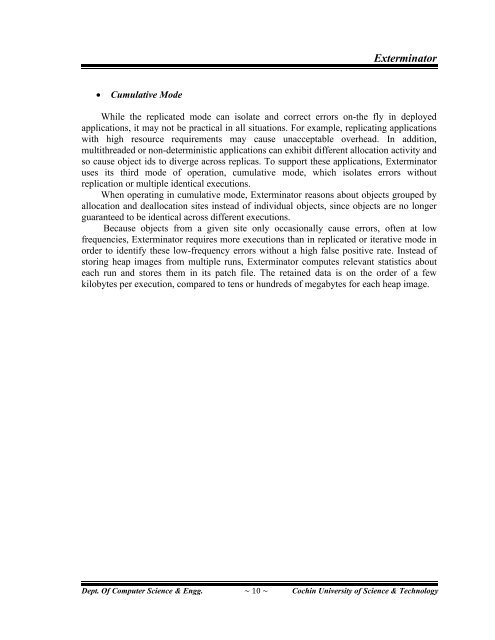Exterminator- A ... with High Probability.pdf - DSpace at CUSAT ...
Exterminator- A ... with High Probability.pdf - DSpace at CUSAT ...
Exterminator- A ... with High Probability.pdf - DSpace at CUSAT ...
Create successful ePaper yourself
Turn your PDF publications into a flip-book with our unique Google optimized e-Paper software.
Cumul<strong>at</strong>ive Mode<br />
<strong>Extermin<strong>at</strong>or</strong><br />
While the replic<strong>at</strong>ed mode can isol<strong>at</strong>e and correct errors on-the fly in deployed<br />
applic<strong>at</strong>ions, it may not be practical in all situ<strong>at</strong>ions. For example, replic<strong>at</strong>ing applic<strong>at</strong>ions<br />
<strong>with</strong> high resource requirements may cause unacceptable overhead. In addition,<br />
multithreaded or non-deterministic applic<strong>at</strong>ions can exhibit different alloc<strong>at</strong>ion activity and<br />
so cause object ids to diverge across replicas. To support these applic<strong>at</strong>ions, <strong>Extermin<strong>at</strong>or</strong><br />
uses its third mode of oper<strong>at</strong>ion, cumul<strong>at</strong>ive mode, which isol<strong>at</strong>es errors <strong>with</strong>out<br />
replic<strong>at</strong>ion or multiple identical executions.<br />
When oper<strong>at</strong>ing in cumul<strong>at</strong>ive mode, <strong>Extermin<strong>at</strong>or</strong> reasons about objects grouped by<br />
alloc<strong>at</strong>ion and dealloc<strong>at</strong>ion sites instead of individual objects, since objects are no longer<br />
guaranteed to be identical across different executions.<br />
Because objects from a given site only occasionally cause errors, often <strong>at</strong> low<br />
frequencies, <strong>Extermin<strong>at</strong>or</strong> requires more executions than in replic<strong>at</strong>ed or iter<strong>at</strong>ive mode in<br />
order to identify these low-frequency errors <strong>with</strong>out a high false positive r<strong>at</strong>e. Instead of<br />
storing heap images from multiple runs, <strong>Extermin<strong>at</strong>or</strong> computes relevant st<strong>at</strong>istics about<br />
each run and stores them in its p<strong>at</strong>ch file. The retained d<strong>at</strong>a is on the order of a few<br />
kilobytes per execution, compared to tens or hundreds of megabytes for each heap image.<br />
Dept. Of Computer Science & Engg. ~ 10 ~ Cochin University of Science & Technology
















